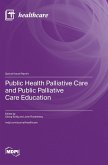- Gebundenes Buch
- Merkliste
- Auf die Merkliste
- Bewerten Bewerten
- Teilen
- Produkt teilen
- Produkterinnerung
- Produkterinnerung
While the book is primarily for public health practitioners including community nurses and physicians, social workers and community planners, this book also serves as a valuable resource for anyone interested in public health and its application in creating healthier societies.
Andere Kunden interessierten sich auch für
![Public Health Palliative Care and Public Palliative Care Education Public Health Palliative Care and Public Palliative Care Education]() Public Health Palliative Care and Public Palliative Care Education72,99 €
Public Health Palliative Care and Public Palliative Care Education72,99 €![The Facility Manager's Guide to Environmental Health and Safety The Facility Manager's Guide to Environmental Health and Safety]() Brian J. GallantThe Facility Manager's Guide to Environmental Health and Safety128,99 €
Brian J. GallantThe Facility Manager's Guide to Environmental Health and Safety128,99 €![The Startup Protocol The Startup Protocol]() Sally Ann FrankThe Startup Protocol191,99 €
Sally Ann FrankThe Startup Protocol191,99 €![Hospital Quality Hospital Quality]() Doug JohnsonHospital Quality159,99 €
Doug JohnsonHospital Quality159,99 €![Safeguarding Physician Wellbeing Safeguarding Physician Wellbeing]() Julie L. WeiSafeguarding Physician Wellbeing179,99 €
Julie L. WeiSafeguarding Physician Wellbeing179,99 €![Gesundheitsökonomische Evaluationen Gesundheitsökonomische Evaluationen]() Oliver Schöffski / J.-Matthias Graf von der Schulenburg (Hrsg.)Gesundheitsökonomische Evaluationen69,99 €
Oliver Schöffski / J.-Matthias Graf von der Schulenburg (Hrsg.)Gesundheitsökonomische Evaluationen69,99 €![Digital-Health-Innovation im Ostseeraum Digital-Health-Innovation im Ostseeraum]() Melissa NawrothDigital-Health-Innovation im Ostseeraum14,99 €
Melissa NawrothDigital-Health-Innovation im Ostseeraum14,99 €-
-
-
While the book is primarily for public health practitioners including community nurses and physicians, social workers and community planners, this book also serves as a valuable resource for anyone interested in public health and its application in creating healthier societies.
Produktdetails
- Produktdetails
- Verlag: Productivity Press
- Seitenzahl: 342
- Erscheinungstermin: 26. Juni 2024
- Englisch
- Abmessung: 260mm x 183mm x 23mm
- Gewicht: 839g
- ISBN-13: 9781032644233
- ISBN-10: 1032644230
- Artikelnr.: 70148979
- Herstellerkennzeichnung
- Libri GmbH
- Europaallee 1
- 36244 Bad Hersfeld
- gpsr@libri.de
- Verlag: Productivity Press
- Seitenzahl: 342
- Erscheinungstermin: 26. Juni 2024
- Englisch
- Abmessung: 260mm x 183mm x 23mm
- Gewicht: 839g
- ISBN-13: 9781032644233
- ISBN-10: 1032644230
- Artikelnr.: 70148979
- Herstellerkennzeichnung
- Libri GmbH
- Europaallee 1
- 36244 Bad Hersfeld
- gpsr@libri.de
Dr. Hari Singh holds an MBBS and an MD in Community Health Administration from Delhi University. He has extensive experience in managing public health projects pertaining to maternal health, child health, adolescent health, family planning, HIV/AIDS, and tuberculosis. Additionally, he has provided technical assistance to several state governments in India to improve the quality of services in public health institutions. He has also been involved in evaluating numerous national health programs and has worked with international funding agencies such as USAID and Danida. Currently, Dr. Singh serves as dean of the School of Public Health at SRM Institute of Science and Technology in Chennai, India, where he teaches public health. He is passionate about developing technical content in a simple language to ensure his readers can easily understand complex medical and health topics.
Preface. Acknowledgments. SECTION I Health and Disease. Chapter 1 What Is
Public Health? Chapter 2 Concept of Primary Health Care. Chapter 3 What Is
Health? Chapter 4 Determinants of Health. Chapter 5 What Are Infectious
Diseases? Chapter 6 What Are Noncommunicable Diseases? Chapter 7
Classification of Diseases. SECTION II Basic Epidemiology. Chapter 8 What
Is Epidemiology? Chapter 9 Disease Transmission. Chapter 10 Natural History
of Diseases. Chapter 11 Measuring Mortality. Chapter 12 Measuring
Morbidity. Chapter 13 Indirect Indicators of Health. Chapter 14 Disease
Surveillance. SECTION III Applied Epidemiology. Chapter 15 Screening of
Diseases. Chapter 16 Disease Prevention. Chapter 17 Epidemiological Study
Designs: An Introduction. Chapter 18 Descriptive Study. Chapter 19
Case-Control Study. Chapter 20 Cohort Study. Chapter 21 Experimental Study.
Chapter 22 Association and Causation. Chapter 23 Bias and Confounding.
Chapter 24 Epidemic Management. SECTION IV Biostatistics. Chapter 25 What
Is Biostatistics? Chapter 26 Organizing Data. Chapter 27 Analyzing Data.
Chapter 28 Measures of Dispersion. Chapter 29 Presenting Data. Chapter 30
Sampling Methods. Chapter 31 Tests of Significance. Chapter 32 Correlation
and Regression. SECTION V Public Health Nutrition. Chapter 33 Nutrition and
Nutrients. Chapter 34 Nutritional Assessment. Chapter 35 Protein-Energy
Malnutrition. Chapter 36 Iron-Deficiency Anemia. Chapter 37 Iodine
Deficiency Disorders. Chapter 38 Vitamin A Deficiency. Chapter 39 Other
Micronutrient Deficiencies. Chapter 40 Diet Planning. Chapter 41 Food
Fortification and Food Additives. Chapter 42 Meat Hygiene and Mushroom
Poisoning. SECTION VI Environmental Health. Chapter 43 What Is Environment?
Chapter 44 Air Pollution. Chapter 45 Water and Its Sources. Chapter 46
Water Pollution and Treatment. Chapter 47 Water Harvesting. Chapter 48
Solid Waste Management. Chapter 49 Human Excreta Disposal. Chapter 50
Hospital Waste Management. Chapter 51 Noise Pollution. Chapter 52
Radiation. Chapter 53 Pesticides. Chapter 54 Housing and Family. SECTION
VII Sociocultural Dimensions of Health. Chapter 55 Sociocultural Practices.
Chapter 56 Gender and Health. Chapter 57 Poverty and Social Security.
Chapter 58 Health-Seeking Behavior. SECTION VIII Maternal and Child Health.
Chapter 59 Maternal Health. Chapter 60 Adolescent Health. Chapter 61 Child
Health. Chapter 62 Integrated Management of Childhood Illness. Chapter 63
Immunization. Chapter 64 Family Planning Programs. Chapter 65 Methods of
Contraception. Chapter 66 What Is Demography? SECTION IX Health Promotion.
Chapter 67 Health Promotion and Health Communication. SECTION X Other
Topics of Public Health. Chapter 68 Health of the Elderly. Chapter 69
Mental Health: A Public Health Concern. Chapter 70 Occupational Health
Hazards. Chapter 71 Occupational Safety of Healthcare Workers. Chapter 72
Disaster Management. Chapter 73 Emerging Diseases. Chapter 74 International
Health. SECTION XI Management of Health Projects. Chapter 75 Health Project
Management. Chapter 76 Planning. Chapter 77 Implementation and Monitoring
and Evaluation. Chapter 78 Quality Improvement. Chapter 79 Basic
Communication Skills. Index.
Public Health? Chapter 2 Concept of Primary Health Care. Chapter 3 What Is
Health? Chapter 4 Determinants of Health. Chapter 5 What Are Infectious
Diseases? Chapter 6 What Are Noncommunicable Diseases? Chapter 7
Classification of Diseases. SECTION II Basic Epidemiology. Chapter 8 What
Is Epidemiology? Chapter 9 Disease Transmission. Chapter 10 Natural History
of Diseases. Chapter 11 Measuring Mortality. Chapter 12 Measuring
Morbidity. Chapter 13 Indirect Indicators of Health. Chapter 14 Disease
Surveillance. SECTION III Applied Epidemiology. Chapter 15 Screening of
Diseases. Chapter 16 Disease Prevention. Chapter 17 Epidemiological Study
Designs: An Introduction. Chapter 18 Descriptive Study. Chapter 19
Case-Control Study. Chapter 20 Cohort Study. Chapter 21 Experimental Study.
Chapter 22 Association and Causation. Chapter 23 Bias and Confounding.
Chapter 24 Epidemic Management. SECTION IV Biostatistics. Chapter 25 What
Is Biostatistics? Chapter 26 Organizing Data. Chapter 27 Analyzing Data.
Chapter 28 Measures of Dispersion. Chapter 29 Presenting Data. Chapter 30
Sampling Methods. Chapter 31 Tests of Significance. Chapter 32 Correlation
and Regression. SECTION V Public Health Nutrition. Chapter 33 Nutrition and
Nutrients. Chapter 34 Nutritional Assessment. Chapter 35 Protein-Energy
Malnutrition. Chapter 36 Iron-Deficiency Anemia. Chapter 37 Iodine
Deficiency Disorders. Chapter 38 Vitamin A Deficiency. Chapter 39 Other
Micronutrient Deficiencies. Chapter 40 Diet Planning. Chapter 41 Food
Fortification and Food Additives. Chapter 42 Meat Hygiene and Mushroom
Poisoning. SECTION VI Environmental Health. Chapter 43 What Is Environment?
Chapter 44 Air Pollution. Chapter 45 Water and Its Sources. Chapter 46
Water Pollution and Treatment. Chapter 47 Water Harvesting. Chapter 48
Solid Waste Management. Chapter 49 Human Excreta Disposal. Chapter 50
Hospital Waste Management. Chapter 51 Noise Pollution. Chapter 52
Radiation. Chapter 53 Pesticides. Chapter 54 Housing and Family. SECTION
VII Sociocultural Dimensions of Health. Chapter 55 Sociocultural Practices.
Chapter 56 Gender and Health. Chapter 57 Poverty and Social Security.
Chapter 58 Health-Seeking Behavior. SECTION VIII Maternal and Child Health.
Chapter 59 Maternal Health. Chapter 60 Adolescent Health. Chapter 61 Child
Health. Chapter 62 Integrated Management of Childhood Illness. Chapter 63
Immunization. Chapter 64 Family Planning Programs. Chapter 65 Methods of
Contraception. Chapter 66 What Is Demography? SECTION IX Health Promotion.
Chapter 67 Health Promotion and Health Communication. SECTION X Other
Topics of Public Health. Chapter 68 Health of the Elderly. Chapter 69
Mental Health: A Public Health Concern. Chapter 70 Occupational Health
Hazards. Chapter 71 Occupational Safety of Healthcare Workers. Chapter 72
Disaster Management. Chapter 73 Emerging Diseases. Chapter 74 International
Health. SECTION XI Management of Health Projects. Chapter 75 Health Project
Management. Chapter 76 Planning. Chapter 77 Implementation and Monitoring
and Evaluation. Chapter 78 Quality Improvement. Chapter 79 Basic
Communication Skills. Index.
Preface. Acknowledgments. SECTION I Health and Disease. Chapter 1 What Is Public Health? Chapter 2 Concept of Primary Health Care. Chapter 3 What Is Health? Chapter 4 Determinants of Health. Chapter 5 What Are Infectious Diseases? Chapter 6 What Are Noncommunicable Diseases? Chapter 7 Classification of Diseases. SECTION II Basic Epidemiology. Chapter 8 What Is Epidemiology? Chapter 9 Disease Transmission. Chapter 10 Natural History of Diseases. Chapter 11 Measuring Mortality. Chapter 12 Measuring Morbidity. Chapter 13 Indirect Indicators of Health. Chapter 14 Disease Surveillance. SECTION III Applied Epidemiology. Chapter 15 Screening of Diseases. Chapter 16 Disease Prevention. Chapter 17 Epidemiological Study Designs: An Introduction. Chapter 18 Descriptive Study. Chapter 19 Case-Control Study. Chapter 20 Cohort Study. Chapter 21 Experimental Study. Chapter 22 Association and Causation. Chapter 23 Bias and Confounding. Chapter 24 Epidemic Management. SECTION IV Biostatistics. Chapter 25 What Is Biostatistics? Chapter 26 Organizing Data. Chapter 27 Analyzing Data. Chapter 28 Measures of Dispersion. Chapter 29 Presenting Data. Chapter 30 Sampling Methods. Chapter 31 Tests of Significance. Chapter 32 Correlation and Regression. SECTION V Public Health Nutrition. Chapter 33 Nutrition and Nutrients. Chapter 34 Nutritional Assessment. Chapter 35 Protein-Energy Malnutrition. Chapter 36 Iron-Deficiency Anemia. Chapter 37 Iodine Deficiency Disorders. Chapter 38 Vitamin A Deficiency. Chapter 39 Other Micronutrient Deficiencies. Chapter 40 Diet Planning. Chapter 41 Food Fortification and Food Additives. Chapter 42 Meat Hygiene and Mushroom Poisoning. SECTION VI Environmental Health. Chapter 43 What Is Environment? Chapter 44 Air Pollution. Chapter 45 Water and Its Sources. Chapter 46 Water Pollution and Treatment. Chapter 47 Water Harvesting. Chapter 48 Solid Waste Management. Chapter 49 Human Excreta Disposal. Chapter 50 Hospital Waste Management. Chapter 51 Noise Pollution. Chapter 52 Radiation. Chapter 53 Pesticides. Chapter 54 Housing and Family. SECTION VII Sociocultural Dimensions of Health. Chapter 55 Sociocultural Practices. Chapter 56 Gender and Health. Chapter 57 Poverty and Social Security. Chapter 58 Health-Seeking Behavior. SECTION VIII Maternal and Child Health. Chapter 59 Maternal Health. Chapter 60 Adolescent Health. Chapter 61 Child Health. Chapter 62 Integrated Management of Childhood Illness. Chapter 63 Immunization. Chapter 64 Family Planning Programs. Chapter 65 Methods of Contraception. Chapter 66 What Is Demography? SECTION IX Health Promotion. Chapter 67 Health Promotion and Health Communication. SECTION X Other Topics of Public Health. Chapter 68 Health of the Elderly. Chapter 69 Mental Health: A Public Health Concern. Chapter 70 Occupational Health Hazards. Chapter 71 Occupational Safety of Healthcare Workers. Chapter 72 Disaster Management. Chapter 73 Emerging Diseases. Chapter 74 International Health. SECTION XI Management of Health Projects. Chapter 75 Health Project Management. Chapter 76 Planning. Chapter 77 Implementation and Monitoring and Evaluation. Chapter 78 Quality Improvement. Chapter 79 Basic Communication Skills. Index.
Preface. Acknowledgments. SECTION I Health and Disease. Chapter 1 What Is
Public Health? Chapter 2 Concept of Primary Health Care. Chapter 3 What Is
Health? Chapter 4 Determinants of Health. Chapter 5 What Are Infectious
Diseases? Chapter 6 What Are Noncommunicable Diseases? Chapter 7
Classification of Diseases. SECTION II Basic Epidemiology. Chapter 8 What
Is Epidemiology? Chapter 9 Disease Transmission. Chapter 10 Natural History
of Diseases. Chapter 11 Measuring Mortality. Chapter 12 Measuring
Morbidity. Chapter 13 Indirect Indicators of Health. Chapter 14 Disease
Surveillance. SECTION III Applied Epidemiology. Chapter 15 Screening of
Diseases. Chapter 16 Disease Prevention. Chapter 17 Epidemiological Study
Designs: An Introduction. Chapter 18 Descriptive Study. Chapter 19
Case-Control Study. Chapter 20 Cohort Study. Chapter 21 Experimental Study.
Chapter 22 Association and Causation. Chapter 23 Bias and Confounding.
Chapter 24 Epidemic Management. SECTION IV Biostatistics. Chapter 25 What
Is Biostatistics? Chapter 26 Organizing Data. Chapter 27 Analyzing Data.
Chapter 28 Measures of Dispersion. Chapter 29 Presenting Data. Chapter 30
Sampling Methods. Chapter 31 Tests of Significance. Chapter 32 Correlation
and Regression. SECTION V Public Health Nutrition. Chapter 33 Nutrition and
Nutrients. Chapter 34 Nutritional Assessment. Chapter 35 Protein-Energy
Malnutrition. Chapter 36 Iron-Deficiency Anemia. Chapter 37 Iodine
Deficiency Disorders. Chapter 38 Vitamin A Deficiency. Chapter 39 Other
Micronutrient Deficiencies. Chapter 40 Diet Planning. Chapter 41 Food
Fortification and Food Additives. Chapter 42 Meat Hygiene and Mushroom
Poisoning. SECTION VI Environmental Health. Chapter 43 What Is Environment?
Chapter 44 Air Pollution. Chapter 45 Water and Its Sources. Chapter 46
Water Pollution and Treatment. Chapter 47 Water Harvesting. Chapter 48
Solid Waste Management. Chapter 49 Human Excreta Disposal. Chapter 50
Hospital Waste Management. Chapter 51 Noise Pollution. Chapter 52
Radiation. Chapter 53 Pesticides. Chapter 54 Housing and Family. SECTION
VII Sociocultural Dimensions of Health. Chapter 55 Sociocultural Practices.
Chapter 56 Gender and Health. Chapter 57 Poverty and Social Security.
Chapter 58 Health-Seeking Behavior. SECTION VIII Maternal and Child Health.
Chapter 59 Maternal Health. Chapter 60 Adolescent Health. Chapter 61 Child
Health. Chapter 62 Integrated Management of Childhood Illness. Chapter 63
Immunization. Chapter 64 Family Planning Programs. Chapter 65 Methods of
Contraception. Chapter 66 What Is Demography? SECTION IX Health Promotion.
Chapter 67 Health Promotion and Health Communication. SECTION X Other
Topics of Public Health. Chapter 68 Health of the Elderly. Chapter 69
Mental Health: A Public Health Concern. Chapter 70 Occupational Health
Hazards. Chapter 71 Occupational Safety of Healthcare Workers. Chapter 72
Disaster Management. Chapter 73 Emerging Diseases. Chapter 74 International
Health. SECTION XI Management of Health Projects. Chapter 75 Health Project
Management. Chapter 76 Planning. Chapter 77 Implementation and Monitoring
and Evaluation. Chapter 78 Quality Improvement. Chapter 79 Basic
Communication Skills. Index.
Public Health? Chapter 2 Concept of Primary Health Care. Chapter 3 What Is
Health? Chapter 4 Determinants of Health. Chapter 5 What Are Infectious
Diseases? Chapter 6 What Are Noncommunicable Diseases? Chapter 7
Classification of Diseases. SECTION II Basic Epidemiology. Chapter 8 What
Is Epidemiology? Chapter 9 Disease Transmission. Chapter 10 Natural History
of Diseases. Chapter 11 Measuring Mortality. Chapter 12 Measuring
Morbidity. Chapter 13 Indirect Indicators of Health. Chapter 14 Disease
Surveillance. SECTION III Applied Epidemiology. Chapter 15 Screening of
Diseases. Chapter 16 Disease Prevention. Chapter 17 Epidemiological Study
Designs: An Introduction. Chapter 18 Descriptive Study. Chapter 19
Case-Control Study. Chapter 20 Cohort Study. Chapter 21 Experimental Study.
Chapter 22 Association and Causation. Chapter 23 Bias and Confounding.
Chapter 24 Epidemic Management. SECTION IV Biostatistics. Chapter 25 What
Is Biostatistics? Chapter 26 Organizing Data. Chapter 27 Analyzing Data.
Chapter 28 Measures of Dispersion. Chapter 29 Presenting Data. Chapter 30
Sampling Methods. Chapter 31 Tests of Significance. Chapter 32 Correlation
and Regression. SECTION V Public Health Nutrition. Chapter 33 Nutrition and
Nutrients. Chapter 34 Nutritional Assessment. Chapter 35 Protein-Energy
Malnutrition. Chapter 36 Iron-Deficiency Anemia. Chapter 37 Iodine
Deficiency Disorders. Chapter 38 Vitamin A Deficiency. Chapter 39 Other
Micronutrient Deficiencies. Chapter 40 Diet Planning. Chapter 41 Food
Fortification and Food Additives. Chapter 42 Meat Hygiene and Mushroom
Poisoning. SECTION VI Environmental Health. Chapter 43 What Is Environment?
Chapter 44 Air Pollution. Chapter 45 Water and Its Sources. Chapter 46
Water Pollution and Treatment. Chapter 47 Water Harvesting. Chapter 48
Solid Waste Management. Chapter 49 Human Excreta Disposal. Chapter 50
Hospital Waste Management. Chapter 51 Noise Pollution. Chapter 52
Radiation. Chapter 53 Pesticides. Chapter 54 Housing and Family. SECTION
VII Sociocultural Dimensions of Health. Chapter 55 Sociocultural Practices.
Chapter 56 Gender and Health. Chapter 57 Poverty and Social Security.
Chapter 58 Health-Seeking Behavior. SECTION VIII Maternal and Child Health.
Chapter 59 Maternal Health. Chapter 60 Adolescent Health. Chapter 61 Child
Health. Chapter 62 Integrated Management of Childhood Illness. Chapter 63
Immunization. Chapter 64 Family Planning Programs. Chapter 65 Methods of
Contraception. Chapter 66 What Is Demography? SECTION IX Health Promotion.
Chapter 67 Health Promotion and Health Communication. SECTION X Other
Topics of Public Health. Chapter 68 Health of the Elderly. Chapter 69
Mental Health: A Public Health Concern. Chapter 70 Occupational Health
Hazards. Chapter 71 Occupational Safety of Healthcare Workers. Chapter 72
Disaster Management. Chapter 73 Emerging Diseases. Chapter 74 International
Health. SECTION XI Management of Health Projects. Chapter 75 Health Project
Management. Chapter 76 Planning. Chapter 77 Implementation and Monitoring
and Evaluation. Chapter 78 Quality Improvement. Chapter 79 Basic
Communication Skills. Index.
Preface. Acknowledgments. SECTION I Health and Disease. Chapter 1 What Is Public Health? Chapter 2 Concept of Primary Health Care. Chapter 3 What Is Health? Chapter 4 Determinants of Health. Chapter 5 What Are Infectious Diseases? Chapter 6 What Are Noncommunicable Diseases? Chapter 7 Classification of Diseases. SECTION II Basic Epidemiology. Chapter 8 What Is Epidemiology? Chapter 9 Disease Transmission. Chapter 10 Natural History of Diseases. Chapter 11 Measuring Mortality. Chapter 12 Measuring Morbidity. Chapter 13 Indirect Indicators of Health. Chapter 14 Disease Surveillance. SECTION III Applied Epidemiology. Chapter 15 Screening of Diseases. Chapter 16 Disease Prevention. Chapter 17 Epidemiological Study Designs: An Introduction. Chapter 18 Descriptive Study. Chapter 19 Case-Control Study. Chapter 20 Cohort Study. Chapter 21 Experimental Study. Chapter 22 Association and Causation. Chapter 23 Bias and Confounding. Chapter 24 Epidemic Management. SECTION IV Biostatistics. Chapter 25 What Is Biostatistics? Chapter 26 Organizing Data. Chapter 27 Analyzing Data. Chapter 28 Measures of Dispersion. Chapter 29 Presenting Data. Chapter 30 Sampling Methods. Chapter 31 Tests of Significance. Chapter 32 Correlation and Regression. SECTION V Public Health Nutrition. Chapter 33 Nutrition and Nutrients. Chapter 34 Nutritional Assessment. Chapter 35 Protein-Energy Malnutrition. Chapter 36 Iron-Deficiency Anemia. Chapter 37 Iodine Deficiency Disorders. Chapter 38 Vitamin A Deficiency. Chapter 39 Other Micronutrient Deficiencies. Chapter 40 Diet Planning. Chapter 41 Food Fortification and Food Additives. Chapter 42 Meat Hygiene and Mushroom Poisoning. SECTION VI Environmental Health. Chapter 43 What Is Environment? Chapter 44 Air Pollution. Chapter 45 Water and Its Sources. Chapter 46 Water Pollution and Treatment. Chapter 47 Water Harvesting. Chapter 48 Solid Waste Management. Chapter 49 Human Excreta Disposal. Chapter 50 Hospital Waste Management. Chapter 51 Noise Pollution. Chapter 52 Radiation. Chapter 53 Pesticides. Chapter 54 Housing and Family. SECTION VII Sociocultural Dimensions of Health. Chapter 55 Sociocultural Practices. Chapter 56 Gender and Health. Chapter 57 Poverty and Social Security. Chapter 58 Health-Seeking Behavior. SECTION VIII Maternal and Child Health. Chapter 59 Maternal Health. Chapter 60 Adolescent Health. Chapter 61 Child Health. Chapter 62 Integrated Management of Childhood Illness. Chapter 63 Immunization. Chapter 64 Family Planning Programs. Chapter 65 Methods of Contraception. Chapter 66 What Is Demography? SECTION IX Health Promotion. Chapter 67 Health Promotion and Health Communication. SECTION X Other Topics of Public Health. Chapter 68 Health of the Elderly. Chapter 69 Mental Health: A Public Health Concern. Chapter 70 Occupational Health Hazards. Chapter 71 Occupational Safety of Healthcare Workers. Chapter 72 Disaster Management. Chapter 73 Emerging Diseases. Chapter 74 International Health. SECTION XI Management of Health Projects. Chapter 75 Health Project Management. Chapter 76 Planning. Chapter 77 Implementation and Monitoring and Evaluation. Chapter 78 Quality Improvement. Chapter 79 Basic Communication Skills. Index.









